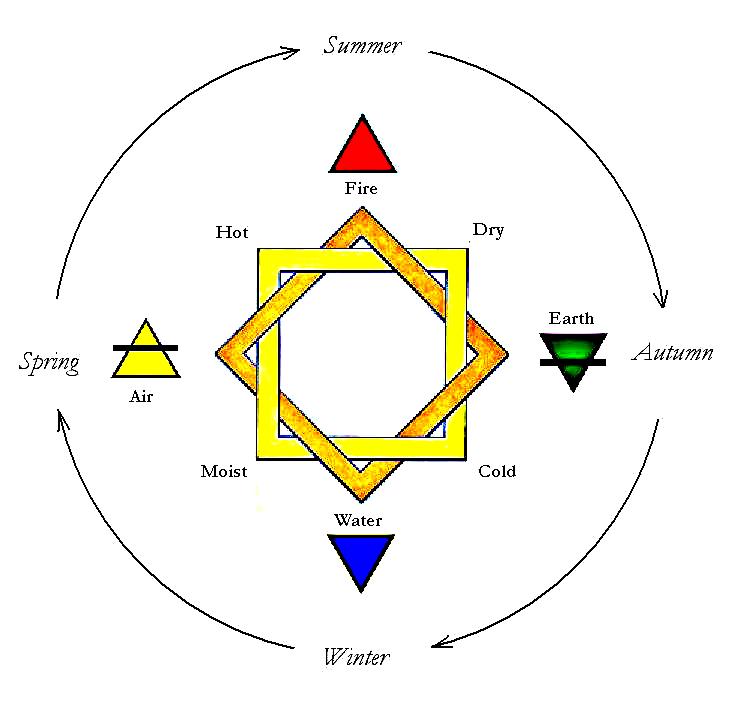by Gary P. Caton, 2019 Celestial Planting Calendar
At the heart of the Celestial Planting Calendar’s methodology is the discovery by Maria Thun during her extensive research that the Moon mediates the effects of the constellations to Earth through the four classical elements of Fire, Water, Air and Earth. Because there are 12 constellations and four elements, the constellations are grouped into four “trigons.” A trigon consists of three constellations which are classically associated with the same element and are approximately equidistant from each other.
Thus, it is often (but not always, because of their unequal sizes) the case that when we have a trine aspect between two planets (separated by 120°), they are also in constellations belonging to the same trigon. In addition to the trine, or division of the circle by three, Maria Thun and George Schmidt primarily use the conjunction and opposition aspects, which represent division of the circle by one and two, respectively.
While it may seem proper to strictly adhere to the methods employed by these respected authorities, based on an understanding of the historical origins of the elements, there is adequate reason for experimenting a little further.
Around 500 BC, the four elements were proposed as “roots” by the pre-Socratic philosopher Empedocles of Acragas. Like later biodynamic pioneers, Empedocles associated the four elements with natural phenomena (sun, earth, sky, and sea). Later, Aristotle took the four qualities described by earlier philosophers (hot, cold, moist and dry) and showed how Empedocles’ four elements changed one into another. For Aristotle, each element had a dominant quality and a secondary quality—i.e., Fire is primarily hot and secondarily dry, or hot becoming dry. When arranged in a square, we see that each element adjacent to another, share a quality, and this introduces a cycle of change via the four seasons. Spring is wet becoming hot (Air), summer is hot becoming dry (Fire) autumn is dry becoming cold (Earth) and winter is cold becoming moist (Water), as in the accompanying figure.

As we see by the triangular symbols used, Air and Fire both share the quality of heat and tend to move upward. Similarly, Earth and Water both share the quality of coolness and tend to settle or move downward. This shared tendency toward a basic direction of movement is where the sextile aspect derives its power. Things going in the same general direction tend to be more cooperative than those going in opposite directions.
We see this same basic thinking reflected in biodynamic theory in several different ways. For instance, in lecture one of Rudolf Steiner’s Agriculture Course the planets are grouped into two types according to their distance, some being nearer and others being farther from the Sun. Moon, Venus and Mercury are connected with the forces of reproduction and growth. Steiner is invoking a downward motion when speaking about the planets closest to the Earth.
He then goes on to say: “Mars, Jupiter and Saturn, working via the silicious nature…opens the plant-being to the wide spaces of the Universe and awakens the senses of the plant-being in such a way as to receive from all quarters of the Universe the forces which are moulded by these distant planets.” Steiner is invoking an upward directed movement when speaking about the planets further from Earth.
Similarly, he says that Moon, Venus and Mercury are activated by Water and Mars, Jupiter and Saturn are activated by warmth (Fire). In lecture seven, he describes the preparations of Horn Manure (BD500) and Horn Silica (BD501) as aiding earthbound and skybound energies, respectively.
The sextile aspect (60°) invokes complimentary trigons which are inherently cooperative, because of their basic directional agreement, being both upward or downward tending. There is evidence of this same thinking in other biodynamic literature. Therefore, the sextile aspect seems like a good candidate for inclusion in the Celestial Planting Calendar. While we may still prefer to work with an opposition or trine, there may not be one of these aspects available to us within the timeframe that our lives afford us for a given activity. In this case, we can use the sextile, particularly if it is between planets which correspond to the trigons and plants we are working with.
For instance, let’s say we want to schedule a wine-tasting event. These are typically best scheduled on fruit days, with the Moon in front of a constellation of the Fire trigon. An even better scenario would be if the Moon were making a trine to a planet also associated with the Fire/Warmth ether, such as Mercury, Saturn or Pluto. However, if we cannot find a day which suits our schedule and has such a trine, a sextile of the Moon with one of those same planets will suffice. Similarly, we could make use of the Moon in front of a constellation of the Air trigon, particularly if it were making a sextile to a Fire/Warmth planet. In this way, the sextile aspect offers additional harmonious opportunities for working with the cosmic forces.
 Gary P. Caton - Astronomer, Writer, Forecaster Gary P. Caton - Astronomer, Writer, Forecaster
Growing up in a rural setting outside Leesburg, Virginia, Gary developed passions for gardening and farming early in life and has lived on working farms.
In 1993 Gary was initiated into the planetary mysteries by seeing alignments in a dream. His deep love of nature fuels his enthusiasm for stargazing and astrophotography. Gary claims it has been a true joy combining his lifelong passion for learning with the tasks of completing the calculations and contributing to the forecasts for this calendar. Based on more than two decades of experience, he incorporates several new elements into this text, including consideration of the sextile aspect and a look at the deeper mysteries of the retrograde loops of Venus and Mars.
www.dreamastrologer.com
|


![]()


 Gary P. Caton - Astronomer, Writer, Forecaster
Gary P. Caton - Astronomer, Writer, Forecaster